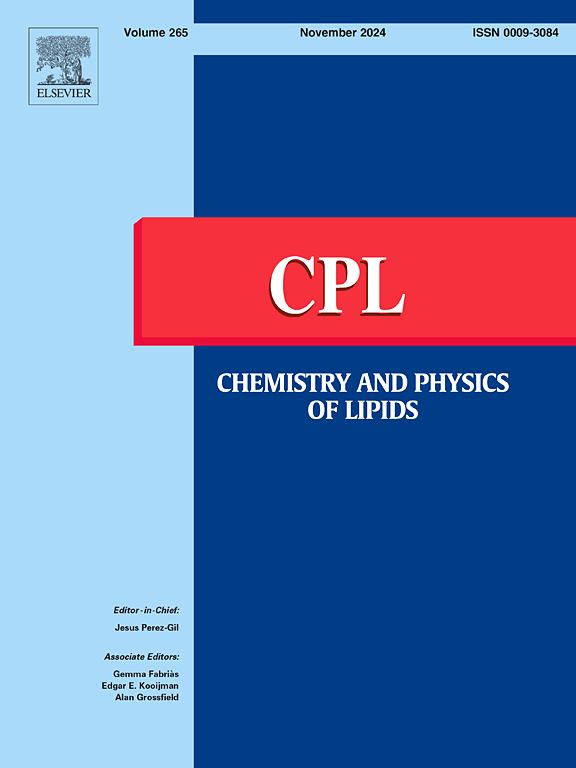不同结构的支链脂肪酸具有不同的抗肝癌活性和特性。
IF 2.8
3区 生物学
Q2 BIOCHEMISTRY & MOLECULAR BIOLOGY
引用次数: 0
摘要
支链脂肪酸(BCFAs)具有潜在的抗癌活性,但由于单体可及性问题,其与直链饱和脂肪酸(SSFAs)的系统评价和比较仍然有限。本研究利用富含BCFA/SSFA混合物的羊毛脂,采用多元线性回归(MLR)和正交偏最小二乘(OPLS)模型,结合HepG2细胞活力、凋亡和细胞周期测定,系统评估了50种脂肪酸的抗肝癌活性。MLR鉴定出iso-C13:0是一种独特的保护性脂肪酸,而ops具有很强的解释力(R2X = 0.827-0.997, R2Y = 0.675-0.782)和关键的抗肝癌脂肪酸,包括SSFAs (C12:0, C13:0, C14:0, C19:0, C21:0)和BCFAs(16-19碳的异-BCFAs, 14-19碳的前-BCFAs)。值得注意的是,SSFAs在某些活性上优于BCFAs,并且出现了结构-活性趋势:奇数碳BCFAs有利于细胞周期阻滞,偶数碳BCFAs促进细胞凋亡,13-21碳脂肪酸表现出更强的活性。该综合方法验证了羊毛脂作为功能性脂质筛选的理想基质,提供了一种在复杂混合物中识别抗癌脂肪酸的方法,挑战了BCFAs的传统优势。本文章由计算机程序翻译,如有差异,请以英文原文为准。
Branched-chain fatty acids with different structure exhibit distinct anti-hepatoma activities and characteristics
Branched-chain fatty acids (BCFAs) exhibit potential anticancer activity, but their systematic evaluation and comparison with straight-chain saturated fatty acids (SSFAs) remain limited due to monomer accessibility issues. This study utilized lanolin, a rich BCFA/SSFA mixture, to systematically assess anti-hepatoma activities of 50 fatty acids using multiple linear regression (MLR) and orthogonal partial least squares (OPLS) models combined with HepG2 cell viability, apoptosis, and cell cycle assays. MLR identified iso-C13:0 as a unique protective fatty acid, while OPLS revealed strong explanatory power (R2X = 0.827–0.997, R2Y = 0.718–0.782) and key anti-hepatoma fatty acids, including SSFAs (C12:0, C13:0, C14:0, C19:0, C21:0) and BCFAs (16–19-carbon iso-BCFAs, 14–19-carbon anteiso-BCFAs). Notably, SSFAs outperformed BCFAs in certain activities, and a structure-activity trend emerged: odd-carbon BCFAs favored cell cycle arrest, even-carbon BCFAs promoted apoptosis, and 13–21-carbon fatty acids showed stronger activity. The integrated approach validated lanolin as an ideal matrix for functional lipid screening, providing a methodology to identify anticancer fatty acids in complex mixtures and challenging the conventional superiority of BCFAs.
求助全文
通过发布文献求助,成功后即可免费获取论文全文。
去求助
来源期刊

Chemistry and Physics of Lipids
生物-生化与分子生物学
CiteScore
7.60
自引率
2.90%
发文量
50
审稿时长
40 days
期刊介绍:
Chemistry and Physics of Lipids publishes research papers and review articles on chemical and physical aspects of lipids with primary emphasis on the relationship of these properties to biological functions and to biomedical applications.
Accordingly, the journal covers: advances in synthetic and analytical lipid methodology; mass-spectrometry of lipids; chemical and physical characterisation of isolated structures; thermodynamics, phase behaviour, topology and dynamics of lipid assemblies; physicochemical studies into lipid-lipid and lipid-protein interactions in lipoproteins and in natural and model membranes; movement of lipids within, across and between membranes; intracellular lipid transfer; structure-function relationships and the nature of lipid-derived second messengers; chemical, physical and functional alterations of lipids induced by free radicals; enzymatic and non-enzymatic mechanisms of lipid peroxidation in cells, tissues, biofluids; oxidative lipidomics; and the role of lipids in the regulation of membrane-dependent biological processes.
 求助内容:
求助内容: 应助结果提醒方式:
应助结果提醒方式:


